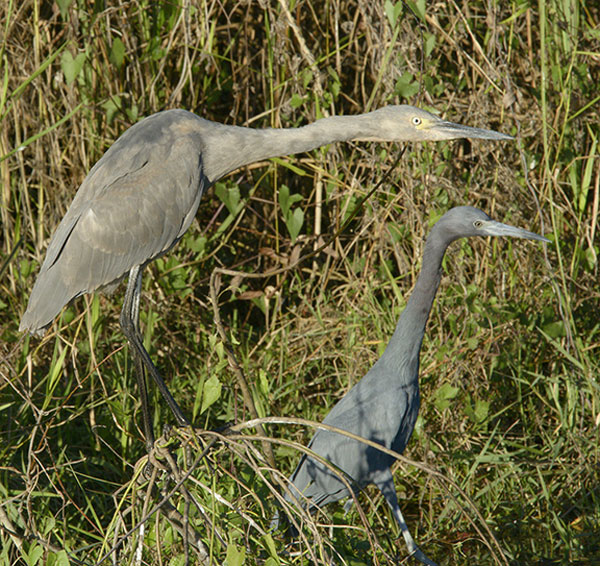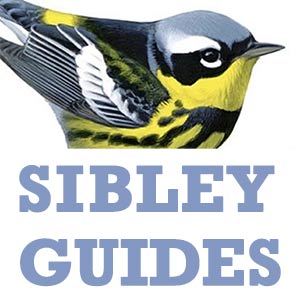Can you identify the two birds in this photo?

It should be immediately obvious that this photo shows two species of dark herons, and their overall slender shape and uniform grayish color, with no distinct markings on head or neck, reduces the options to two: Little Blue Heron and Reddish Egret.
It is rare to see these two species side-by-side, so we rarely get to appreciate the much larger size of Reddish Egret. This kind of grassy freshwater pool is normal habitat for Little Blue Heron, but Reddish Egret is almost always found on expansive shallow saltwater lagoons.
It’s also a great opportunity to compare the differences in overall color, as well as details of the color of bill, lores, eye, legs, etc.
This is an immature Reddish Egret, less than a year old, based on its lack of plumes, drab grayish color overall and slightly paler and brownish tips on all of the wing coverts. Compared to an adult Little Blue Heron the immature Reddish Egret’s paler ashy-gray and mottled color is easily distinguishable. An adult Reddish Egret would be even more distinctive in color, with clean gray body and shaggy reddish neck.


Any idea why the lores on this Reddish Egret are yellow?
Reddish Egret, Little Blue Heron
Mark the lores on immature Reddish Egrets can occasionally be yellow (see below), but I do no know the actual frequency; from my experience in Texas I’d say it is rare but not exceptional. Sadly all of my field guides show the lores as dark, with no mention of occasional yellow in the lores (David I only have your original large-format guide, so I don’t know if you have included this in any later versions?)
Here is a link to my web page on the subject:
http://www.martinreid.com/Main%20website/reddishegret.html
– I raised the matter on Id-Frontiers back in 2011, since this feature could affect a Records Committee’s assessment of a vagrant Reddish Egret (imagine a description with no photos of the bird above – “…lores yellow…” and how this might be viewed). I did not get any replies.
With permission of the photographer I have posted a picture on my website a friend of mine took at Sea Pines Forest Preserve, Hilton Head, SC on April 15, 2014. From the Carolinas to CA a robust debate is taking place with both those of the Reddish Egret (white phase) persuasion and those of the Little Blue Heron (juvenile) citing Sibley. You can view the photograph at http://ronstorey.com/Egret-Heron/. What say ye, Sir?
Hi Ron, Thanks for the link. This is definitely a Little Blue Heron, about one-year-old. The bluish color of the base of the bill effectively eliminates Reddish Egret, and the shape and proportions are a good fit for Little Blue Heron ( Reddish Egret would look longer-legged, longer-necked, with a longer and more parallel-sided bill).
I’m confused, so u r saying it is not remotely possible 4 the smaller “Little Blue Heron” 2 B a young “Reddish Egret”? One wonderful fact about Herons is ,whenever I have seen them it has been in highly populated urban areas. Once behind a Dairy Queen in Menomonee Falls, Wi. where it stood over 1hr.next 2 sml.Bridge by tall grass bending from its weight into flowing water causing a natural filter 4 sml fish 2 become caught 4 mature Heron to grab. I have pix of another Heron at tiny creek on BrownDeer rd. next 2 Walgreens@60th st.
i realize that I am late with this post, but like they say “better late than never”. Thank you for your identification of the Little Blue Heron, we all learned from your comment and it resolved a long discussion.